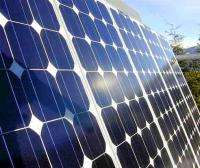Carbon nanotubes may cheaply harvest sunlight

(PhysOrg.com) -- A new alternative energy technology relies on the element most associated with climate change: carbon.
University of Wisconsin-Madison researchers are studying how to create inexpensive, efficient solar cells from carbon nanotubes, which are sheets of carbon rolled into seamless cylinders one nanometer in diameter. Many researchers are studying how to use nanotubes for mechanical and electronics applications, but materials science and engineering assistant professor Michael Arnold is one of the first to apply them to solar energy.
"We are developing new materials and methods to create scalable, inexpensive, stable and efficient photovoltaic solar cell technologies," Arnold says. "Semiconducting carbon nanotubes have remarkable electronic and optical properties that are ideally suited for photovoltaics, so they are an interesting starting point."
Carbon is a promising choice for solar cells because it is an abundant, inexpensive element, and carbon nanotubes have excellent electrical conductivity and strong optical absorptivity. Most current solar cells use silicon, which converts 10 to 30 percent of sunlight absorbed into electricity. This is a good rate, but silicon cells are expensive.
"The cost is upfront for silicon cells, and the cost per kilowatt-hour is five times more than you'd pay for coal over 20 years — that's not very motivating for people," says Arnold. With carbon nanotubes, he hopes to achieve efficiency comparable to silicon solar cells for less cost.
Arnold says solar is a valuable energy source since the sun outputs approximately 1,000 watts per square yard. A solar cell that is only 20 percent efficient would generate about 200 watts per square yard on a sunny day, so coating the roof of an average 40-square yard house with solar cells would make a significant dent in the average energy needs of the household. To have an effect on the national electric grid, Arnold envisions expansive fields of solar cells built in desert regions.
"Solar is a viable technology for producing energy," Arnold says. "It's just too expensive right now."
To create the new carbon nanotube solar cells, Arnold and his students grow nanotube structures and then separate the useful semi-conducting nanotubes from undesirable metallic ones. They also separate the tubes according to diameter, which determines a particular nanotube's bandgap, or wavelength of light the tube can absorb. Certain bandgaps are more suitable than others for absorbing sunlight.
After sorting out the useful nanotubes, the team wraps them in a semi-conducting polymer to make the tubes soluble. They turn the combined nanotubes and polymer into a solution, which can be sprayed in a thin film onto transparent indium-tin-oxide coated glass substrates. The researchers then deposit an electron-accepting semiconductor and a negative electrode on top of the nanotubes to complete the entire cell.
In creating the new solar cells, Arnold, who is funded by the National Science Foundation, is attempting to answer a variety of fundamental science and research questions. He is studying how charge is generated in the nanotubes in response to light and how different electron-accepting materials affect the efficiency and speed of the separation of that charge.
"The driving question is, can we understand how to both process the tubes to get the morphology we want, and can we also learn how light creates charges in our carbon nanotube materials and how these charges separate?" he says.
Provided by University of Wisconsin-Madison (news : web)
















